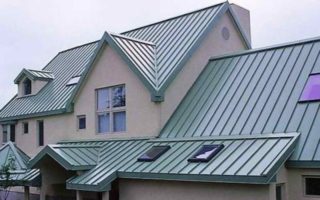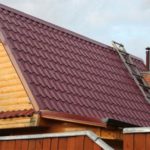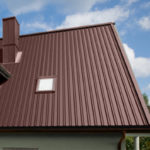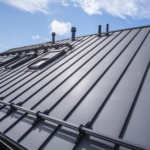The metal roof is distinguished by its presentable appearance and great durability. It is fire resistant and can handle extreme weather conditions well.
Features of a metal roof

In the Soviet era, the metal roof was not popular. It was replaced by another solution - cladding with slate sheets. Nowadays, iron roofing has become more common thanks to the new generation of materials that are resistant to corrosion.
Galvanized sheet metal is usually used. Such constructions serve for a long time.
Roofing metal is used for various types of roofs with any level of inclination, as well as for garages and canopies for cars.
Varieties of metal roofing
If you want to install a metal roof on your home, it is important to choose a suitable coating. Materials vary in composition and design.
Corrugated board
On sale you can find a profiled sheet marked with the letter H (bearing), C (wall) and NS (multifunctional). For roofing, you can use any of the options, but products with the letter C are more often used for walls of terraces and similar rooms. The material is easily mounted on the lathing. It can also be used on a slightly sloping roof (with an angle of about 5 degrees).
Sheets are available in various lengths (up to 12 m), so that the surface can be coated with a minimum number of joints, reducing the likelihood of leakage.
Disadvantage - the material allows sounds to pass through: it will be noisy inside the room during rain and hail.
Metal tile
A roof made of metal tiles will have similar characteristics to corrugated board, since the material is also made of steel with a polymer coating. Instead of large sheets, small ones are produced, usually a little more than a meter wide. Piece elements are mounted so that an overlap is created on each side.
Sheet or roll iron
An iron roof can be made using a seam covering. This is the name of the sheets, fastened together by inserting the curved end of one element into the hook-shaped bend of the second. In the past, mallets were used for joining, now folding covers are produced with special locks.
Seam decking elements come in different lengths, so that the roof is obtained with a minimum number of joints. The thickness of the roof covering must be greater than 0.5 mm. The base is usually galvanized steel and coated with a paint or polymer composition.
Popular metals and alloys
The range of coatings is not limited to steel roofing. Aluminum is distinguished by its lightness and ductility. Because of this, it is often used for complex roofs. It does not undergo corrosive processes, it serves for a long time (up to 80 years).
The most expensive metal for roofing is copper. The roof can last for over a century. The zinc-based alloy has a comparable service life, high strength, and is more affordable in terms of price.
Pros and cons of metal roofing
The coatings are attractive, above all, due to their resistance to atmospheric factors. They are resistant to mold, precipitation, temperature extremes. Other pluses of metal coatings include:
- ease of installation;
- reliability, long service life;
- fire resistance;
- no need for complex care;
- ease of snow sliding from the surface, so that it does not linger on it;
- the possibility of recycling.
The downside of metal is its heavy weight, the base of the building must withstand such a load. In addition, the coating has poor sound insulation qualities.
DIY installation and repair rules
Before installation, you need to check the integrity of the coating: there should be no peeling, cracks, swollen places on it.
Stock up on fasteners suitable for the material being used. For the folding method, you will need clamps. With one side they are driven into the crate structure, the other into a standing seam. Crutches are mounted along the overhang of the cornice, holding the facing structure. The distance between them is 70 cm, and the indentation is at least 15. The second strip of the covering is shifted by 6 cm. This is necessary to separate the recumbent folds. Excess material is cut with metal scissors.
Seamed joints help drain water from the roof surface.
When installing at a height, you need to take care of safety belts and other safety measures.
Methods for repairing a metal roof are determined by the extent of the damage. If there are a large number of holes or other defects, the coating must be replaced. In case of local damage, only the affected fragment is subject to replacement (over the entire width of the strip).
Defect detection and elimination
Leak detection is often the reason for roof repairs. They are caused by mechanical influences or poor sealing of technical holes. Diagnosis is carried out in sunny weather. One master examines the condition of the roof from the attic. If damaged rafters, signs of leaks or rust are found, the worker begins to knock. At this time, the second master, located on the roof, draws chalk around the area where the sound was coming from. This is how the boundaries of the fragment in need of repair are determined. Its shape depends on the specifics of the damage: painting, waterproofing, patching.
If there are minor surface defects on the roof (up to 0.5 cm long), they can be covered with a special compound using a spatula. A silicone or acrylic sealant designed for metal work is suitable.












